The Art of Cher Hart: Sharing Her Illustration Journey
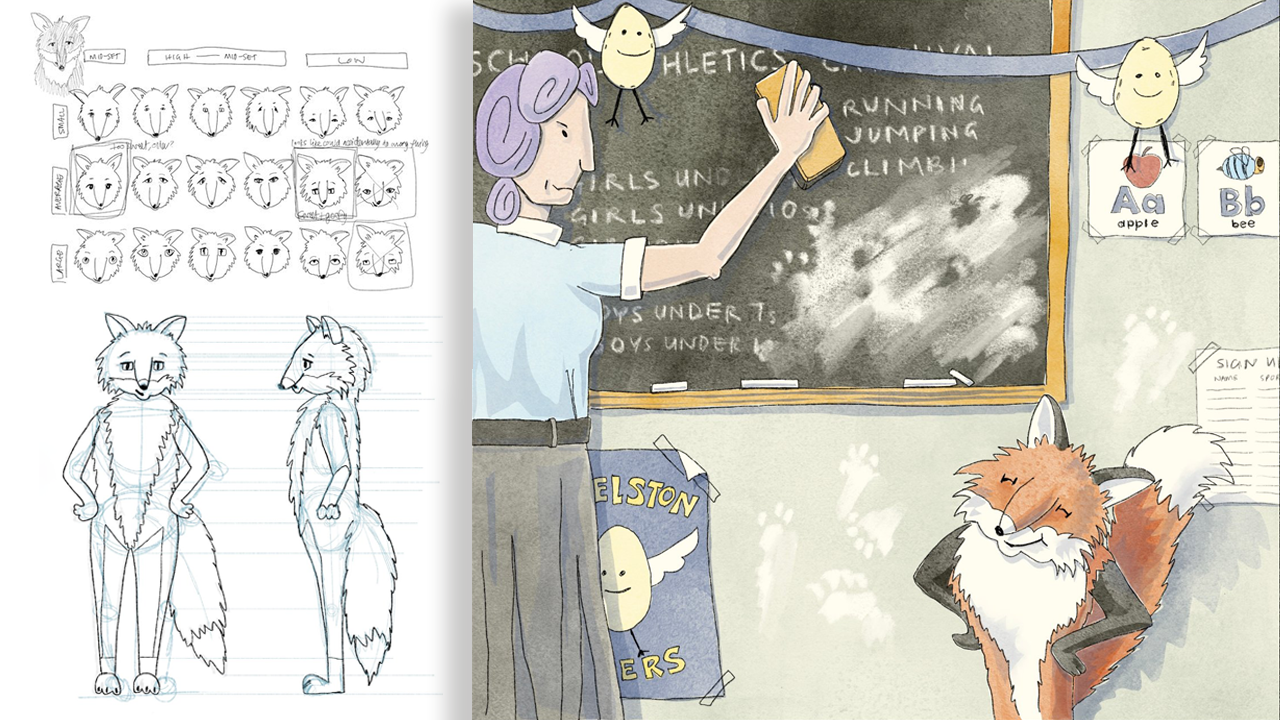
My name is Cher Hart and I live in inland southeastern Australia with my husband and our quirky black rescue greyhound, Connie. When I’m not illustrating, I make maps for grown-ups and wrangle environmental spatial data.
If I were to describe my illustration style, I would say… lively, organic shapes, colour, and linework that captures the essence of character.
I have a background in illustration and graphic design and have always had a secret desire to work as a children’s picture book illustrator. I had recently gotten as far as admitting that I wanted to make a career out of this, but I guess I didn’t quite believe I could do it. I felt I didn’t have the specific knowledge and experience with children’s picture book illustration to put myself out there.
Although I knew I could draw and impart character to my illustrations, I wasn’t sure that I could draw characters consistently, interpret someone else’s manuscript, or create a meaningful and interesting visual narrative. I had been hearing great things about Nina’s courses for a while and, after doing her free, online 3-hour workshop, I knew the Picture Book Illustration e-Course (PBIC) was for me. I signed up straight away. Before PBIC, I could only sheepishly tell people that I, uh, maybe hoped to someday, you know, be, um, a children’s picture book illustrator, haha.
Before PBIC, I could only sheepishly tell people that I, uh, maybe hoped to someday, you know, be, um, a children’s picture book illustrator, haha.
Now, after PBIC, I say it with confidence, excitement, and joy. I am working towards becoming a picture book illustrator. In fact, I am a picture book illustrator (I just haven’t been published yet)! This is who I am and what I want to do with my life. And now I feel I can do it.
What results did you get from the Picture Book Illustration e-Course?
I produced a complete main character and explored some supporting characters, completed thumbnails for the whole manuscript, created larger storyboard pieces for 4 double-page spreads, and completed final illustrations for 2 double-page spreads.
This course filled in the gaps in skill, knowledge, and confidence that I had around children’s picture book illustration. It confirmed (to me) that I can do it, and I now feel ready to put myself out there.
Each week, I dedicate 5-10 hours towards, maybe sometimes more. I spent a lot of time working on it in my head.
Did you have a plan going into PBIC?
I had my own manuscript in mind as a possibility when going into the course, but decided to follow the advice of working on the class manuscript. I’m extremely happy that I did because it gave me the invaluable experience of interpreting someone else’s story, thoughts, and intention while bringing my own self to it. This is, of course, essential for being a picture book illustrator!, and the experience let me know that I could illustrate more than just my own ideas.
Sharing and seeing other people’s approaches also helped me feel connected to the group. It was fantastic to see each person’s unique take on the story and this also helped me gain confidence in my own approach—because it was my own.
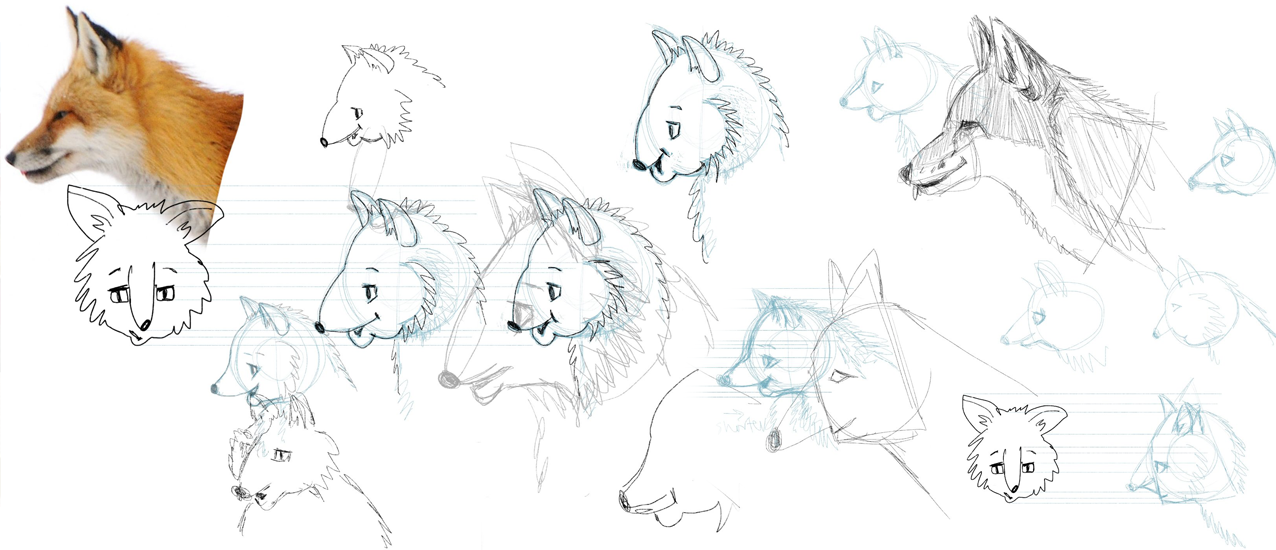
What was the best thing about the course?
There are so many great things about the course. Nina is a fantastic teacher, the course is really well-structured and it is filled with all the advice needed to gain a good understanding of what is involved in illustrating a picture book from start to finish. The course builds on itself and provides just the right guidance at just the right time.
In addition to this—and at least as important—Nina, her guests, the other participants, and the course itself managed to create a supportive and accepting environment and to instill in us an open, learning, joyful mindset, a feeling of comradery and a feeling that this picture book illustration career dream is possible.
What was the worst thing about the course?
Learning how to get around and interact on Facebook. I never mastered how to catch the very beginning of the live sessions. [Head scratch]
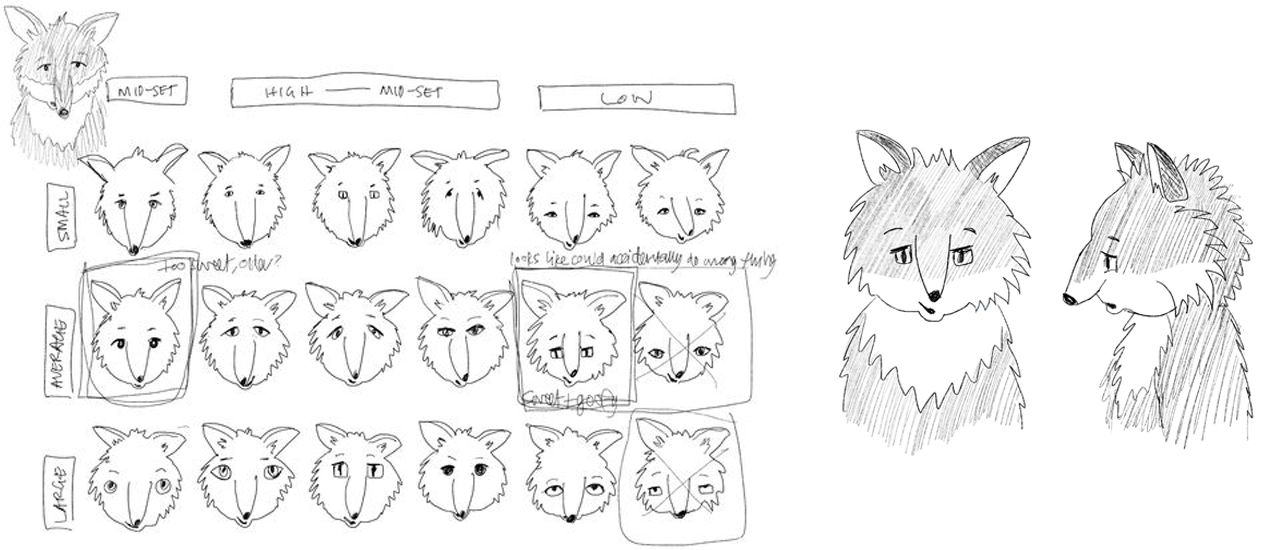
Character Design
How did the course help with your character design process?
I had taken one of Nina’s character design Skillshare courses a few years before but—for some reason—had never applied it to a project. The PBIC process really helped me understand the story, the characters, my interpretation of the characters, and come up with something that I felt captured my feeling of who the main character was.

The character map process was invaluable to me. The instructions, guidance, and feedback on how to create a character map were very useful, and the age progression comparison charts and experience were terrific!
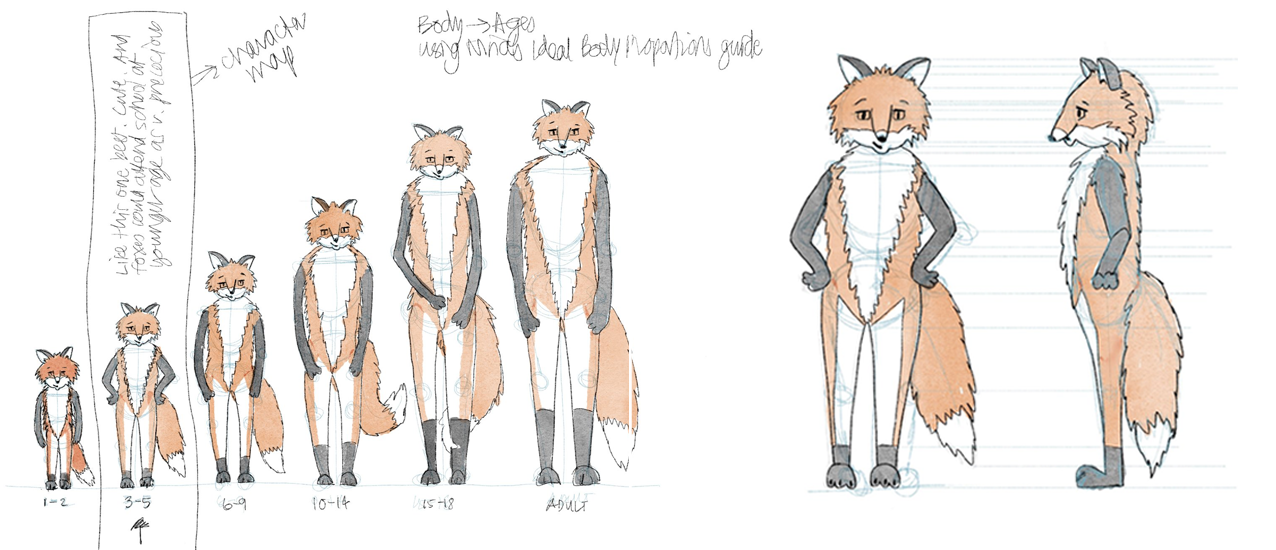
It was great to experience first-hand (not just by reading about it) how important and valuable it is to create character maps for all your characters before moving on to other parts of the picture book illustration process.
What was your experience receiving feedback?
It was, of course, daunting to post my first piece in the group forum but, as promised, it was a very supportive environment and I loved getting Nina’s feedback.
Nina’s advice was always generous, supportive, and insightful. She always seemed to be able to see what was not working and why, and she gave suggestions for improvements while still making you feel like you’d done a fantastic job! I’d love to keep her in my pocket to check all of my future work, knowing that she would always find a way to improve it and make me feel good about what I’d done.
Storyboarding
Talk us through the process of thumbnail sketches.
With a background in graphic design and a long-time interest in picture books, I have done many thumbnail sketches. But (shame) I had never created them for an entire picture book or with so much thought. And it was not easy!

Despite what I had read before the course, I don’t think I realised how important this stage of a picture book is. It was definitely worth the effort as it helped me develop a better understanding of my take on the characters and the story. I will never again skimp or feel guilty for taking the time to do this step (over and over, if necessary) until I get it right.
How did you find working with the larger storyboard format?
I have never done this step before because I tend to get bogged down in detail and perfectionism. Consequently, my work can become overworked or stiff, so I’ve tended to jump from rough ideas or thumbnails to finished artwork to maintain spontaneity and freshness (and avoid debilitating self-criticism).
However, after going through this experience with Nina’s guidance, I would not skip this step again as it really gave me a chance to work things out before jumping to a final piece. This, in turn, meant that I could still explore details without committing to them and I didn’t, in fact, have to labor as much on unresolved sections (thereby avoiding the risk of perfectionism paralysis kicking in!).
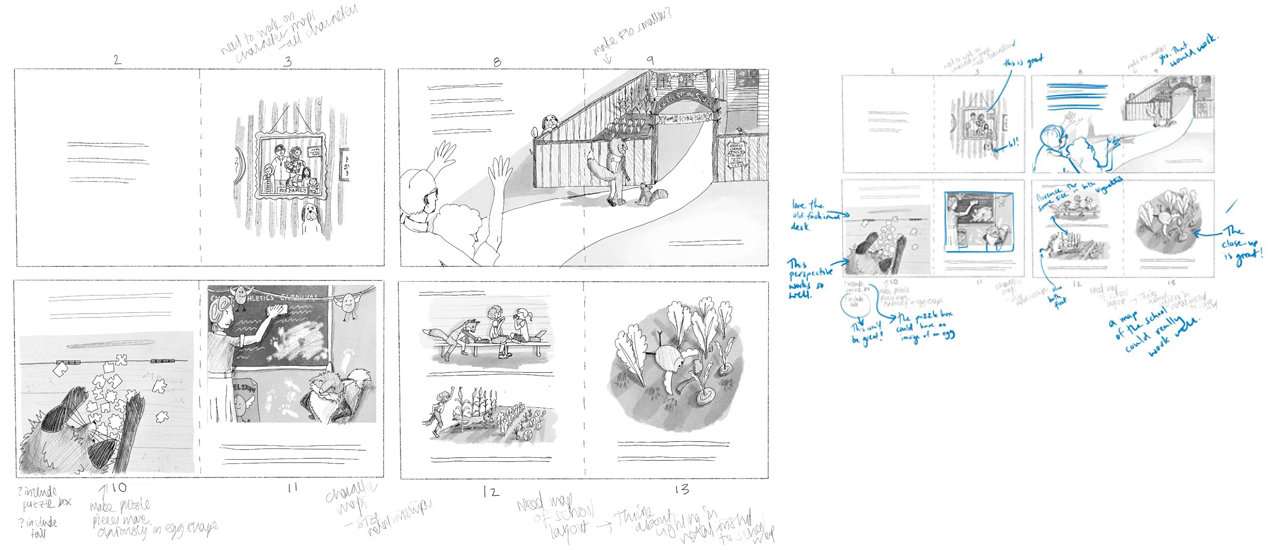
I did most of my illustrating for this course on my iPad, so I pretty much did it everywhere—in my study, in bed, at the dining table, on the lounge in front of the TV, at cafés, while waiting for appointments, in the car (not while it was moving) and wherever I found myself on trips away. I worked on the course on my days off and on the weekends, both as a discipline and when the mood took me.
Over the last couple of years, I have switched from traditional to digital media, and the iPad is quick and convenient. In some ways, it frees me up and allows me to relax and let go of perfectionistic fear. It is very easy to hit undo, add a new layer or alter or erase things that don’t work out the first time. But, at other times, I still really need to feel and experience working on paper with media that you cannot instantly change. I think it is all of the bits that you can’t undo or erase that give a drawing interest, depth, and character, so I try to keep this traditional approach even when working digitally.

Illustrating the Final artwork
How did you choose your final piece?
Thanks to excellent advice throughout the course, I chose the piece that I had the most fun with during the development stages. It was also one that I thought would work well when accompanied by the pages before and after it so that I could present a series of three double-page spreads to demonstrate (and prove to myself) my ability to create a visual narrative. (This was another great piece of advice from the course.)
Describe your final illustration.
I illustrated Florence in front of a messy chalkboard after having done a ‘great’ job at wiping it down, with Mrs. Clack looking on and not amused. For me, this really captured some of the main aspects of (my) Florence’s character, such as her eagerness and sense of pride coupled with her rather wild, unrefined ways and her unawareness of her ‘flaws’.
While illustrating it, I was thinking about who Florence was and how she felt at that moment, and then the same for Mrs. Clack. Although I was happy with what I’d come up with and felt I’d managed to capture the humour and details about Florence’s character and story that I had intended, I was still as nervous as ever to post the final piece.
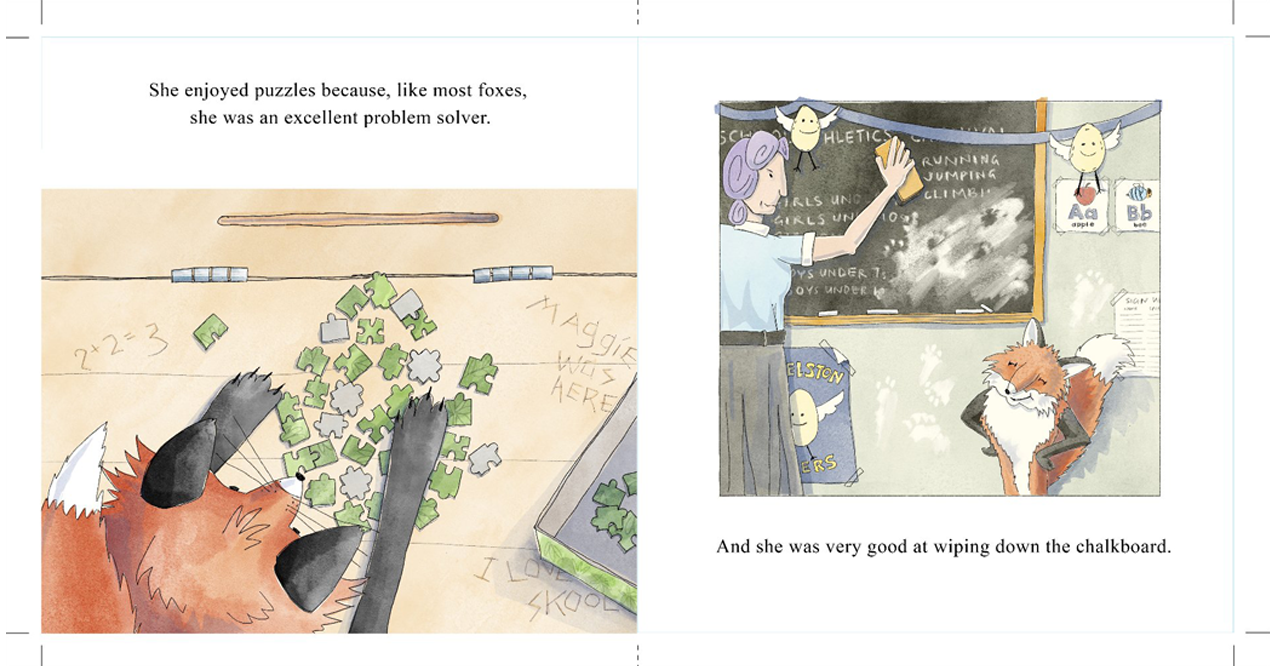
What’s next for you?
I will be approaching publishers to peddle my illustration wares as well as my solo and co-created book ideas. I’m feeling really excited about getting out there and making this happen!
To find out more about Cher and her work, you can follow her on
- Website: www.cherhart.com
- Instagram: www.instagram.com/cherhartdesign/
- Pinterest: www.pinterest.com.au/CherHartDraws

If you are interested in the Picture Book Illustration e-Course
- Click on the link to find out more about the Picture Book Course (self-paced) and Nina's other courses.
- The next PBIC Live will take place Feb, 2024.
- in the meantime, you can follow Nina on Instagram and Facebook



